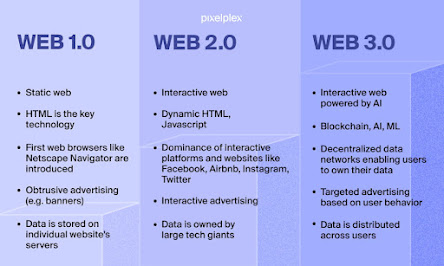We all know that a new era of internet is coming i.e Web 3.0. But before knowing about it we should know what is web 2.0 and how it's affecting our present day to day life.
Web 2.0 describes the current state of the internet, which has more user-generated content and usability for end- users compared to its earlier incarnation, Web 1.0. Web 2.0 generally refers to the 21st-century Internet applications that have transformed the digital era in the aftermath of the dotcom bubble
Web 1.0 was the first version of World wide web, Its evolution took placefrom roughly 1989 to 2004. Personal web pages were common, consisting mainly of static pages hosted on ISP run web servers, or on free web hosting services such as Tripod and the now-defunct GeoCities With Web 2.0, it became common for average web users to have social-networking profiles (on sites such as Myspace and Facebook) and personal blogs (sites like Blogger, Tumblr and LiveJournal) through either a low cost web hosting service or through a dedicated host In general, content was generated dynamically allowing readers to comment directly on pages in a way that was not common previously
Some Web 2.0 capabilities were present in the days of Web 1.0, but were implemented differently For example, a Web 1.0 site may have had a guestbook page for visitor comments instead of a comment section at the end of each page (typical of Web 2.0),
The term "Web 2.0" was coined by Darcy DiNucci, an information architecture consultant, in her January 1999 article "Fragmented Future"
The arrival of Web 2.0 has added many new features to the web applications; it has revolutionized the information sharing, user-oriented design, interoperability on the Internet This has provided information sharing in a way that was never dreamed about few years ego
Web 2.0 provides a much independent solution to interact or commute thoughts with each other through the various online social media's. There are many Web 2.0 sites which have made the online information exchange very users interactive like: blogs, wikis, video-sharing websites, social networking websites, web applications etc.
The Internet based tools like RSS, social bookmarking, press release, online marketing, blog's, forums etc made an everlasting impression on people's lives as it has crossed the hurdle of socio-economic barriers. Web 2.0 tools are available free and are widely used by people, some of the most noticeable are:
- Facebook
- Myspace
- WordPress
- Blogger
- Diggi
- Del.icio.us
- Chrome
- Flickr
- Twitter
- YouTube
- Gmail
All of the above provide an interactive platform where reviews, opinions, likes etc can be shared among the online users group. It has increased the rate of participation of users on online websites and hence given a wide horizon to the online community. Web 2.0 has definitely provided a better functionality and allows the visitor to communicate with the website in a much better prospective.
Now comes Web 3.0 a set of values and technical applications that define a new era of the World Wide Web and it's third version. We will learn more about Web 3.0 in later sessions and think you for visiting us.








Good post. I'm from Netherlands and I really enjoy your blogs.
ReplyDeleteThank you so much ! Please share it among your peers so that others can enjoy too :D
DeleteWil do <3
Deletelove it
ReplyDeleteVery informative, I'm from USA and I really enjoyed your blog
ReplyDeleteBonjour mon ami. Continuez votre bon travail. Au revoir.
ReplyDeleteLove u and your work <3
ReplyDeleteHello bro I'm from Kolkata. You should write more articles. You got talent innit.
ReplyDelete